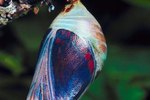
The caterpillar is the larval stage of a moth or butterfly, both members of taxonomic order Lepidoptera, one of 24 orders of insects. Caterpillars share structures and adaptations with the larvae of other insects, but their unique attributes help identify them.
From Eggs to Adults
Depending on the insect, changing from egg to adult is a three- or four-stage process. Complete metamorphosis has four stages: egg, larva, pupa and adult. The butterfly or moth emerges from the egg into the larval stage -- the time when she’s actually a caterpillar -- and pupates. Caterpillars' time is consumed eating and growing, preparing to pupate. In the pupal stage, caterpillars form protective covers, called chrysalides for butterflies or cocoons for moths, where they stay until they've changed into adult form. They emerge to reproduce and die, perpetuating the cycle.
Larvae Legs
The legs are a good place to start identifying insect larvae. Caterpillars have prolegs -- stubby legs on their abdomens -- and segmented “true” legs on their thoraxes. All caterpillars have five or fewer pairs of prolegs and three pairs of true legs. Sawflies, easily confused with caterpillars and members of the order Hymenoptera, have fleshy legs on all segments of their abdomen. Many beetles in their larval state, in the order Coleoptera, have segmented legs on their thoraxes but no prolegs. Many of the legless larvae are in the order Diptera, including the drain fly. A caterpillar’s legs are helpful for inching along foliage and hanging on to leaves, useful at dinnertime.
Using Their Heads
Caterpillars have well-defined, tough head capsule. They're not the only larvae with distinct heads -- sawfly larvae have a similar characteristic -- but the larvae of many other bugs are headless. Crane fly heads are completely hidden in their thoraxes, while fly maggots have no heads at all. They have eyes, but they’re not very useful, able to distinguish light and dark only. Some species of caterpillars appear to have large eyes, but these are for show. They don’t help caterpillar vision but can intimidate potential predators.
All Grown Up
It’s easy to tell when caterpillars have developed into their final stages -- a monarch butterfly isn’t likely to be confused with an adult sawfly, though their larvae are quite alike. Moths and butterflies are distinguished from other insects by their wings. All but a few adult caterpillars have two pair of wings, which are covered with dust-like scales to small too be seen by the naked eye. If you touch a butterfly or moth you’ll likely have a bit of this residue on your fingers. When they're adults, you can tell different species apart more readily than when they're in their caterpillar form.
Altogether Unique
Caterpillars are tiny and vulnerable, attractive prey to birds, rodents and other insects. However, nature gave them tools to help them discourage or fool their enemies. Some use color to blend in with the vegetation they feed from; others use bright colors to warn off predators of their poisonous nature. Some caterpillars are covered in spiky hairs that emit toxins.
References
- BugGuide.net: Overview of Orders of Insects
- Enchanted Learning: Caterpillar Anatomy
- Texas A&M AgriLife Extension: Overview of Insect Orders
- Britannica.com: Lepidopteran
- Wet Tropics Management Authority: Tropical Fact Sheets: Butterfly Defence Strategies
- Museum of Science and Industry: MOSI Outside: Caterpillar Anatomy: Senses and Defenses
- University of Kentucky College of Agriculture, Food and Environment: Recognizing Insect Larval Types
- Alberta Agriculture and Regional Development: Caterpillars and Caterpillar-Like Larvae
- University of Montana-Missoula: Northern Rockies Natural History Guide: How Insects Develop
- The Lepidopterist's Society: Frequently Asked Questions
Photo Credits
-
Hemera Technologies/Photos.com/Getty Images




